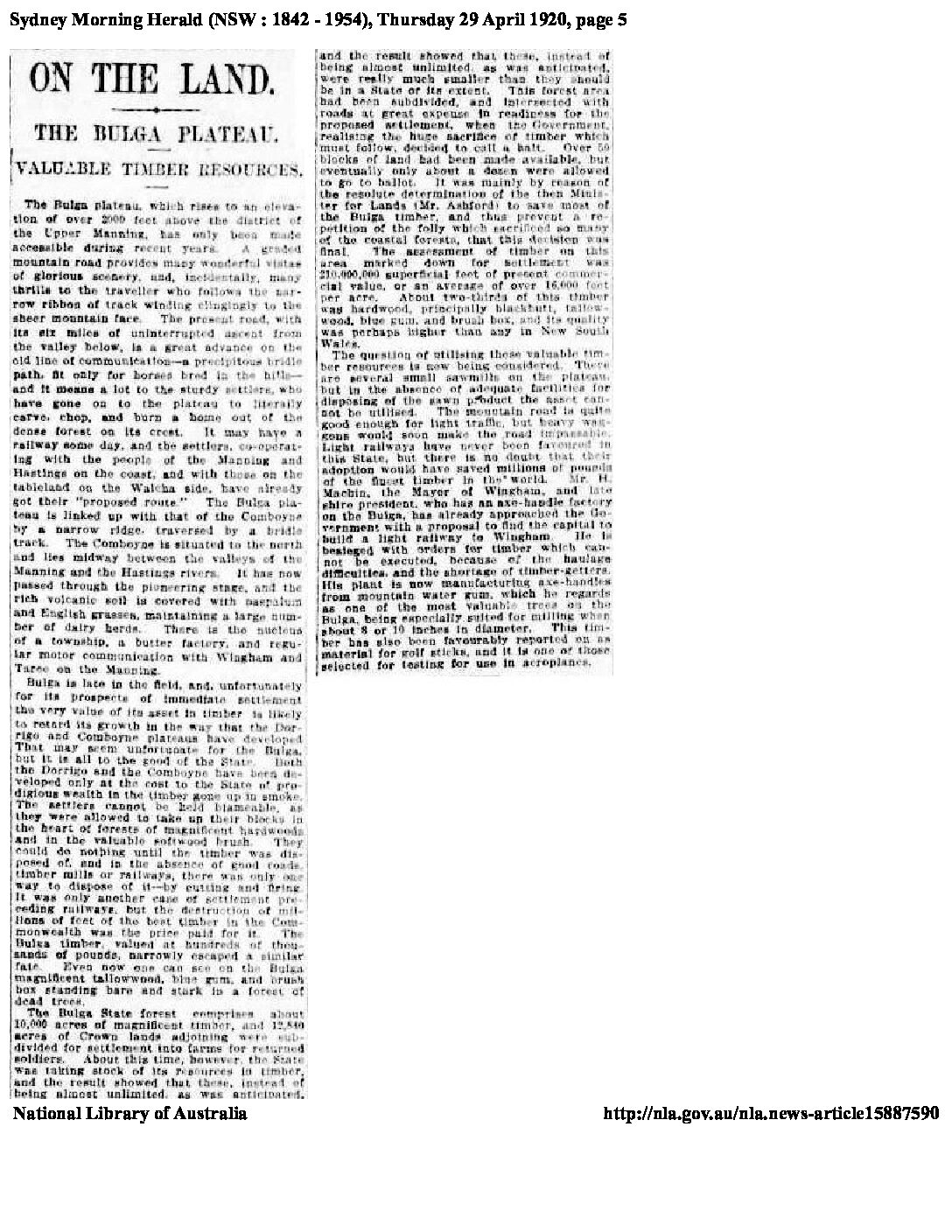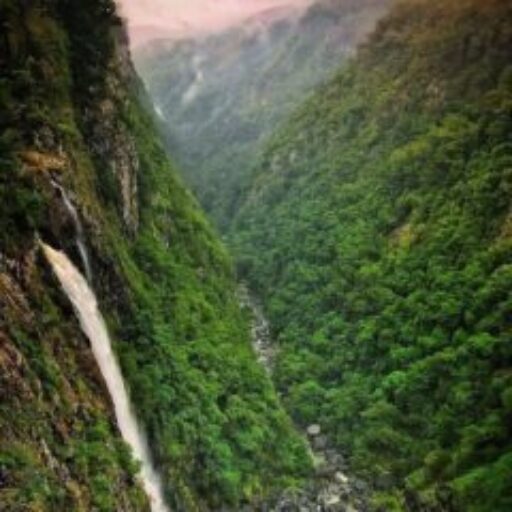
This was an interesting article in the Newspaper.
ON THE LAND
THE BULGA PLATEAU.
VALUABLE TIMBER RESOURCES.
The Bulga plateau, which rises to an eleva-
tion of over 2000 feet above the district of
the Upper Manning, has only been made
accessible during recent years. A graded
mountain road provides many wonderful vistas
of glorious scenery, and, incidentally, many
thrills to the traveler who follows the nar-
row ribbon of track winding clingingly to the
sheer mountain face. The present road, with
its six miles of uninterrupted ascent from
the valley below, is a great advance on the
old line of communication – a precipitous bridle
path, fit only for horses bred In the hills
and it means a lot to the sturdy settlers, who
have gone on to the plateau to literally
carve, chop, and burn a home out of the
dense forest on its crest. It may have a
railway some day, and the settlers, co-operat-
ing with the people of the Manning and
Hastings on the coast, and with those on the
tableland on the Walcha side, have already
got their “proposed route.” The Bulga pla-
teau is linked up with that of the Comboyne
by a narrow ridge, traversed by a bridle
track. The Comboyne is situated to the north
and Iles midway between the valleys of the
Manning and the Hastings rivers. It has now
passed through the pioneering stage, and the
rich volcanic soil is covered with paspalum
and English grasses, maintaining a large num–
ber of dairy herds. There is the nucleus
of a township, a butter factory, and regu-
lar motor communication with Wingham and
Taree on the Manning.
Bulga is late in tho field, and, unfortunately
for its prospects of Immediate settlement
the very value of its asset in timber is likely
to retard its growth in the way that the Dor-
rigo and Comboyne plateaus have developed
That may seem unfortunate for the Bulga,
but it is all to the good of the Stale. Both,
the Dorrigo and the Comboyne have been de–
veloped only at the cost to the State of pro-
digious wealth In the timber gone up in smoke
The settlers cannot be held blameable as
they were allowed to take up their blocks in
the heart of forests of magnificent hardwoods
and in the valuable softwood brush. They
could do nothing until the timber was dis-
posed of, and in the absence of good roads,
timber mills or railways, there was only one
way to dispose of it – by cutting and firing.
It was only another case of settlement pre-
ceding railways, but the destruction of mil-
lions of feet of the best timber in the Com-
monwealth was the price paid for It. The
Bulga timber, valued at hundreds of thou-
sands of pounds, narrowly oscaped a similar
fate. Even now one can see on the Bulga
magnificent tallowwood, blue gum, and brush
box standing bare and stark in a forest of
dead trees.
The Bulga State forest comprises about
10,000 acres of magnificent timber, and 12,840
acres of Crown lands adjoining were sub-
divided for settlement Into farms for returned
soldiers. About this time, however, the State
was taking stock of its resources in timber,
and the result showed that these, instead of
being almost unlimited, as was anticipated,
were really much smaller than they should
be in a State of its extent. This forest area
had been subdivided, and intersected with
roads at great expense in readiness for the
proposed settlement, when tho Government,
realising the huge sacrifice of timber which
must follow, decided to call a halt. Over 50
blocks of land had been made available, but
eventually only about a dozen were allowed
to go to ballot. It was mainly by reason of
the resolute determination of the then Minis-
ter for Lands (Mr. Ashford) to save most of
the Bulga timber, and thus prevent a re-
petition of the folly which sacrificed so many
of the coastal forests, that this decision was
final. The assessment of timber on this
area marked down for settlement was
210,000,000 superficial feet of present commer-
cial value, or an average of over 16,000 feet
per acre. About two-thirds of this timber
was hardwood, principally blackbutt, tallow-
wood, blue gum. and brush box, and Its quality
was perhaps higher than any in New South
Wales.
The question of utilising these valuable tim-
ber resources Is now being considered. There
are several small sawmills on the plateau,
but in the absence of adequate facilities for
disposing of the sawn product the asset can-
not be utilised. The mountain road is quite
good enough for light traffic, but heavy wag-
gons would soon make the road Impassable.
Light railways have never been favoured in
this State, but there is no doubt that their
adoption would have saved millions of pounds
of the finest timber In the world. Mr. H.
Machin, the Mayor of Wingham, and late
shiro president, who has an axe-handle factory
on the Bulga, has already approached the Go–
vernment with a proposal to find the capital to
build a light railway to Wingham. He Is
besieged with orders for timber which can-
not be executed, because of the haulage
difficulties, and the shortago of timber-getters.
His plant is now manufacturing axe-handles
from mountain water gum. which he regards
as ono of the most valuable trees on the
Bulga, being especially suited for milling when
about 8 or 10 Inches in diameter. This tim-
ber has also been favourably reported on as
material for golf sticks, and it is one of those
selected for testing for use in aeroplanes.
ON THE LAND
THE BULGA PLATEAU.
VALUABLE TIMBER RESOURCES.
The Bulga plateau, which rises to an eleva-
tion of over 2000 feet above the district of
the Upper Manning, has only been made
accessible during recent years. A graded
mountain road provides many wonderful vistas
of glorious scenery, and, incidentally, many
thrills to the traveler who follows the nar-
row ribbon of track winding clingingly to the
sheer mountain face. The present road, with
its six miles of uninterrupted ascent from
the valley below, is a great advance on the
old line of communication – a precipitous bridle
path, fit only for horses bred In the hills
and it means a lot to the sturdy settlers, who
have gone on to the plateau to literally
carve, chop, and burn a home out of the
dense forest on its crest. It may have a
railway some day, and the settlers, co-operat-
ing with the people of the Manning and
Hastings on the coast, and with those on the
tableland on the Walcha side, have already
got their “proposed route.” The Bulga pla-
teau is linked up with that of the Comboyne
by a narrow ridge, traversed by a bridle
track. The Comboyne is situated to the north
and Iles midway between the valleys of the
Manning and the Hastings rivers. It has now
passed through the pioneering stage, and the
rich volcanic soil is covered with paspalum
and English grasses, maintaining a large num–
ber of dairy herds. There is the nucleus
of a township, a butter factory, and regu-
lar motor communication with Wingham and
Taree on the Manning.
Bulga is late in tho field, and, unfortunately
for its prospects of Immediate settlement
the very value of its asset in timber is likely
to retard its growth in the way that the Dor-
rigo and Comboyne plateaus have developed
That may seem unfortunate for the Bulga,
but it is all to the good of the Stale. Both,
the Dorrigo and the Comboyne have been de–
veloped only at the cost to the State of pro-
digious wealth In the timber gone up in smoke
The settlers cannot be held blameable as
they were allowed to take up their blocks in
the heart of forests of magnificent hardwoods
and in the valuable softwood brush. They
could do nothing until the timber was dis-
posed of, and in the absence of good roads,
timber mills or railways, there was only one
way to dispose of it – by cutting and firing.
It was only another case of settlement pre-
ceding railways, but the destruction of mil-
lions of feet of the best timber in the Com-
monwealth was the price paid for It. The
Bulga timber, valued at hundreds of thou-
sands of pounds, narrowly oscaped a similar
fate. Even now one can see on the Bulga
magnificent tallowwood, blue gum, and brush
box standing bare and stark in a forest of
dead trees.
The Bulga State forest comprises about
10,000 acres of magnificent timber, and 12,840
acres of Crown lands adjoining were sub-
divided for settlement Into farms for returned
soldiers. About this time, however, the State
was taking stock of its resources in timber,
and the result showed that these, instead of
being almost unlimited, as was anticipated,
were really much smaller than they should
be in a State of its extent. This forest area
had been subdivided, and intersected with
roads at great expense in readiness for the
proposed settlement, when tho Government,
realising the huge sacrifice of timber which
must follow, decided to call a halt. Over 50
blocks of land had been made available, but
eventually only about a dozen were allowed
to go to ballot. It was mainly by reason of
the resolute determination of the then Minis-
ter for Lands (Mr. Ashford) to save most of
the Bulga timber, and thus prevent a re-
petition of the folly which sacrificed so many
of the coastal forests, that this decision was
final. The assessment of timber on this
area marked down for settlement was
210,000,000 superficial feet of present commer-
cial value, or an average of over 16,000 feet
per acre. About two-thirds of this timber
was hardwood, principally blackbutt, tallow-
wood, blue gum. and brush box, and Its quality
was perhaps higher than any in New South
Wales.
The question of utilising these valuable tim-
ber resources Is now being considered. There
are several small sawmills on the plateau,
but in the absence of adequate facilities for
disposing of the sawn product the asset can-
not be utilised. The mountain road is quite
good enough for light traffic, but heavy wag-
gons would soon make the road Impassable.
Light railways have never been favoured in
this State, but there is no doubt that their
adoption would have saved millions of pounds
of the finest timber In the world. Mr. H.
Machin, the Mayor of Wingham, and late
shiro president, who has an axe-handle factory
on the Bulga, has already approached the Go–
vernment with a proposal to find the capital to
build a light railway to Wingham. He Is
besieged with orders for timber which can-
not be executed, because of the haulage
difficulties, and the shortago of timber-getters.
His plant is now manufacturing axe-handles
from mountain water gum. which he regards
as ono of the most valuable trees on the
Bulga, being especially suited for milling when
about 8 or 10 Inches in diameter. This tim-
ber has also been favourably reported on as
material for golf sticks, and it is one of those
selected for testing for use in aeroplanes.

